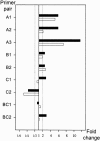Differential expression of var gene groups is associated with morbidity caused by Plasmodium falciparum infection in Tanzanian children
- PMID: 16790763
- PMCID: PMC1489729
- DOI: 10.1128/IAI.02073-05
Differential expression of var gene groups is associated with morbidity caused by Plasmodium falciparum infection in Tanzanian children
Abstract
The var gene family of Plasmodium falciparum encodes the variant surface antigen Plasmodium falciparum erythrocyte membrane protein 1 (PfEMP1). PfEMP1 is considered an important pathogenicity factor in P. falciparum infection because it mediates cytoadherence to host cell endothelial receptors. var genes can be grouped into three major groups, A, B, and C, and the conserved var genes, var1-4, according to sequence similarities in coding and noncoding upstream regions. Using real-time quantitative PCR in a study conducted in Tanzania, the var transcript abundances of the different var gene groups were compared among patients with severe, uncomplicated, and asymptomatic malaria. Transcripts of var group A and B genes were more abundant in patients with severe malaria than in patients with uncomplicated malaria. In general, the transcript abundances of var group A and B genes were higher for children with clinical malaria than for children with asymptomatic infections. The var group C and var1-like transcript abundances were similar between the three sample groups. A transcript abundance pattern similar to that for var group A was observed for var2csa and var3-like genes. These results suggest that substantial and systematic differences in var gene expression exist between different clinical presentations.
Figures


Similar articles
-
Evidence for in vitro and in vivo expression of the conserved VAR3 (type 3) plasmodium falciparum erythrocyte membrane protein 1.Malar J. 2012 Apr 25;11:129. doi: 10.1186/1475-2875-11-129. Malar J. 2012. PMID: 22533832 Free PMC article.
-
Genetic diversity of expressed Plasmodium falciparum var genes from Tanzanian children with severe malaria.Malar J. 2012 Jul 16;11:230. doi: 10.1186/1475-2875-11-230. Malar J. 2012. PMID: 22799500 Free PMC article.
-
Preferential expression of domain cassettes 4, 8 and 13 of Plasmodium falciparum erythrocyte membrane protein 1 in severe malaria imported in France.Clin Microbiol Infect. 2017 Mar;23(3):211.e1-211.e4. doi: 10.1016/j.cmi.2016.10.012. Epub 2016 Oct 20. Clin Microbiol Infect. 2017. PMID: 27773760
-
PfEMP1: an antigen that plays a key role in the pathogenicity and immune evasion of the malaria parasite Plasmodium falciparum.Int J Biochem Cell Biol. 2009 Jul;41(7):1463-6. doi: 10.1016/j.biocel.2008.12.012. Epub 2008 Dec 25. Int J Biochem Cell Biol. 2009. PMID: 19150410 Review.
-
A family affair: var genes, PfEMP1 binding, and malaria disease.Curr Opin Microbiol. 2006 Aug;9(4):374-80. doi: 10.1016/j.mib.2006.06.006. Epub 2006 Jun 30. Curr Opin Microbiol. 2006. PMID: 16814594 Review.
Cited by
-
Acquisition of IgG to ICAM-1-Binding DBLβ Domains in the Plasmodium falciparum Erythrocyte Membrane Protein 1 Antigen Family Varies between Groups A, B, and C.Infect Immun. 2019 Sep 19;87(10):e00224-19. doi: 10.1128/IAI.00224-19. Print 2019 Oct. Infect Immun. 2019. PMID: 31308082 Free PMC article.
-
Human monoclonal IgG selection of Plasmodium falciparum for the expression of placental malaria-specific variant surface antigens.Parasite Immunol. 2009 Jun;31(6):341-6. doi: 10.1111/j.1365-3024.2009.01097.x. Parasite Immunol. 2009. PMID: 19493213 Free PMC article.
-
Do we know enough to find an adjunctive therapy for cerebral malaria in African children?F1000Res. 2017 Nov 22;6:2039. doi: 10.12688/f1000research.12401.1. eCollection 2017. F1000Res. 2017. PMID: 29250318 Free PMC article. Review.
-
Patterns of protective associations differ for antibodies to P. falciparum-infected erythrocytes and merozoites in immunity against malaria in children.Eur J Immunol. 2017 Dec;47(12):2124-2136. doi: 10.1002/eji.201747032. Epub 2017 Sep 13. Eur J Immunol. 2017. PMID: 28833064 Free PMC article.
-
Plasmodium falciparum PfEMP1 Modulates Monocyte/Macrophage Transcription Factor Activation and Cytokine and Chemokine Responses.Infect Immun. 2017 Dec 19;86(1):e00447-17. doi: 10.1128/IAI.00447-17. Print 2018 Jan. Infect Immun. 2017. PMID: 29038124 Free PMC article.
References
-
- Baruch, D. I., B. L. Pasloske, H. B. Singh, X. Bi, X. C. Ma, M. Feldman, T. F. Taraschi, and R. J. Howard. 1995. Cloning the P. falciparum gene encoding PfEMP1, a malarial variant antigen and adherence receptor on the surface of parasitized human erythrocytes. Cell 82:77-87. - PubMed
-
- Berendt, A. R., D. J. Ferguson, and C. I. Newbold. 1990. Sequestration in Plasmodium falciparum malaria: sticky cells and sticky problems. Parasitol. Today 6:247-254. - PubMed
-
- Bian, Z., and G. Wang. 2000. Antigenic variation and cytoadherence of PfEMP1 of Plasmodium falciparum-infected erythrocyte from malaria patients. Chin. Med. J. 113:981-984. - PubMed
-
- Bull, P. C., M. Kortok, O. Kai, F. Ndungu, A. Ross, B. S. Lowe, C. I. Newbold, and K. Marsh. 2000. Plasmodium falciparum-infected erythrocytes: agglutination by diverse Kenyan plasma is associated with severe disease and young host age. J. Infect. Dis. 182:252-259. - PubMed
Publication types
MeSH terms
Substances
LinkOut - more resources
Full Text Sources
Other Literature Sources
Research Materials

